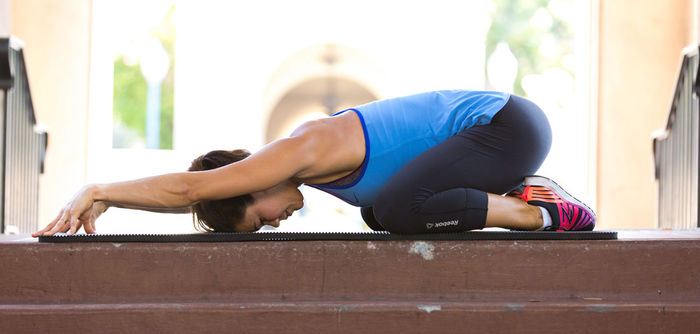“Everything in moderation” guides my nutrition and fitness decisions. I firmly that being healthy does NOT have to be hard, restrictive or compulsive. Recently, I’ve watched in horror as HIIT has overtaken the fitness world. Now, don’t get me wrong—I love a good high-intensity interval training session and we know that it works. But lately it seems that HIIT is the ONLY way you can exercise, which leaves me worried that people are overdosing on HIIT when a little bit would do the trick.
Look at the number of magazine covers devoted to HIIT, the industry articles explaining and debating it, the selfies documenting the HIIT workout that brought the instructor to his knees today (and yesterday and the day before, too), as well as the number of workout DVDs and infomercials devoted to these hardcore workouts. You can’t escape it—it’s everywhere you turn. And, sure, there are a few professionals out there suggesting that people exercise caution with the volume of HIIT training they do, but in consumer land HIIT has become the one-size-fits-most approach to quick results and we, as an industry, are certainly delivering.
HIIT is hot—and, when something is hot, we feel compelled to comply and give our customers what they want. In doing so, our clients can no longer escape it even in our capable, trusted hands so they begin to believe this is the answer to their prayers. You’ve got HIIT on the schedule everywhere and instructors who have classes that aren’t titled HIIT are sneaking it in, too (yes, we’ve witnessed Reformer Tabata). You gotta admit, deep down you know that too much of a good thing is NOT the best for you or those you teach. But we need a voice of reason.
As professionals, we need to TRULY understand what HIIT is and then educate people about what they should and shouldn’t be doing to get the most from their workouts—collectively, not individually. Furthermore, we must keep ourselves in check and not let the need to be popular outweigh our responsibility to act as the educated professional tasked with LEADING consumers to the fitness promise land.
What is HIIT?
HIIT—high-intensity interval training—includes a shorter workout of intense intervals with varying work-to-rest ratios. If your clients want to get all they believe HIIT has to offer, they have to go hard! Because of its popularity, however, HIIT now comes in all shapes and sizes these days: strength, cardio, hybrid, equipment based, non-equipment based and beyond; short, long and everywhere in between. It’s hard to discern between the well-intentioned, well-manufactured HIIT workouts and those that are just trying to capitalize on the popularity of the name. (Side note: The same can be said for Tabata workouts.)
As Fabio Comana, exercise physiologist and well-known fitness industry educator, put it in one of his latest lectures, “True HIIT has origins in performance, whereby an athlete aims to get bigger, stronger or faster, or enhance sustained performance (e.g., 45 seconds on the ice). The training purpose is to systematically overload systems with intense training through repetitions (e.g., 5 seconds of 40-yard sprints) and, then, take appropriate recoveries to enable near maximal performance or sustained intensities (e.g., specific wattage or load).” Bottom line, this is not always what we are seeing done in workouts that are labeled HIIT and that has a variety of consequences.
What’s the problem?
Members fall in love with a format for different reasons, but more often than not, the promised outcome of the workout is what intrigues most. So if members believe that HIIT can get results faster and in a shorter amount of time, that’s what they expect. And, you know what I always say, “Conflict is when expectation doesn’t meet reality.” The potential for disappointment is high! They come, they sweat, they weigh—and when the results are not as they would imagine, they go harder, longer or more often with the same result. So when the increased effort and volume lead to exhaustion without a new jean size, they’re frustrated and, many times, quit all together. Or if they do continue because the workouts are great, injuries can result.
Why can’t we stop?
As an instructor, I’m a people pleaser. I want people to like fitness, I want them to like the class, I want them to like me and I want them to come back. When something becomes so popular, I have a feeling it’s a slam-dunk and I want a piece of the pie. I want to teach the format and, if it’s not technically my class, I want to get in on the action. Can you relate?
When members take hold of a heavily marketed concept they can be very vocal. It can be hard to walk that fine line between giving them what they want and what they need. Of course, this typically falls in the hands of the program managers to create schedules that are well rounded, but also well attended. Quite the conundrum when a format is SO popular and others may have fallen out of favor.
And, finally, I like HIIT because it’s FUN to teach! With minimal choreography required, I just need a watch, some high-energy tunes and a dose of good motivation to be successful. The format lends itself to being enjoyable for the members and me. What’s not to love?
What can we do?
First, get educated. Truly understand HIIT, what it has to offer and how members can achieve the benefits of HIIT. Take a look at some of the articles referenced below. Part of the issue is we’ve heard the sound-bite, but may not have dug deep enough to be able to deliver the best information to our participants.
Second, exercise caution in scheduling. Of course, there may not be much we as instructors can do here. But managers need to take a 40,000-foot view of the schedule and program with variety and purpose. We should avoid every genre of class having a HIIT spin just because it’s popular! This needs to be reflected in both class titles and descriptions. Even more importantly, we have to get our team on the same page and insist on folks following the script. If HIIT is NOT in your class, it shouldn’t be done. PERIOD.
Finally, program smart with these three simple steps:
1. HIIT requires lower volume.
Translated: Shorter intervals, shorter workouts, less times per week is the best recipe for getting what you need from your HIIT workouts.
2. HIIT requires recovery.
Translated: Work harder at coaching the recovery than the work; insist on compliance during the recoveries and resist the urge to keep the class at a fevered pitch for 60 minutes. You’ll also need to promote proper recovery between workouts and the benefits of cross-training the heart.
3. HIIT requires effort.
Translated: Focus on coaching appropriate EFFORT for the intervals in a variety of ways; effort doesn’t have to equal hurt—you’re looking for overload in your heart and lungs, which can come from many things, not just jumping! Remind members that effort is one of the key ingredients in receiving the benefits and you can’t give the effort if you haven’t followed rules #1 & #2.
If you’re a fitness ProFESSIONAL, and not just a fitness ProSUMER (the term I give to instructors and trainers who are professional consumers of fitness and turn their decision-making over to consumer demand), you are nodding your head in agreement, aching to comment “amen” and pressing the share button faster than you can burpee—then I say, keep it up. Put some pressure on the person beside you. Share this information with other fitness pros. Talk to folks who teach formats similar to yours and opposite you (in same time slots) to be sure you’re not giving your clients an opportunity to overdose on HIIT. And be sure to engage your owners and managers in conversations about the best way to construct a schedule to give members what they want, but also steer them toward what they need.
Steady state workouts are still viable. Low-end endurance is still beneficial. And strength training with normal sets and reps still works. Avoid throwing the baby out with the bath water just because the media has taken a message and run with it. HIIT is hot, HIIT is great, HIIT is fun—do it. But always remember that HIIT is best when it peacefully coexists with all of the other great workouts we know and love. Here’s to helping our members avoid HIITing rock bottom.
Great articles to read, review and repost:
ACE’s High Intensity Interval Training ProSource Issue
Has High-Intensity Exercise Gotten Out of Hand?, By Amanda Vogel
Extreme Fitness: How Intense Is Too Intense?, By Amanda Vogel
Metabolic Effects of HIIT, by Len Kravitz, PhD




 by
by 













 by
by